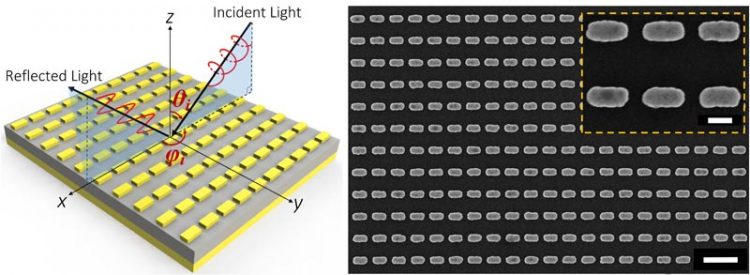Two-Dimensional Metamaterial Surface Manipulates Light

Zhi Hao Jiang, Penn State On the left, circularly polarized light is converted to a linearly polarized wave upon reflection in a metasurface-based quarter-wave plate. On the right, a top-view FESEM image of the fabricated nanostructure showing the nanorod array. (Bottom scale bar - 400 nm. Top scale bar – 100 nm)
“We have designed and fabricated a waveplate that can transform the polarization state of light,” said Zhi Hao Jiang, a postdoctoral fellow in electrical engineering and lead author of a recent paper in Scientific Reports explaining their invention. “Polarization is one of the most fundamental properties of light. For instance, if we transform linearly polarized light into circularly polarized light, this could be useful in optical communication and biosensing.”
Optical waveplates with broadband polarization conversion over a wide field of view are highly sought after. Conventional waveplates, made from multilayer stacks of materials such as quartz, have difficulty achieving both broadband and wide-angle conversion.
Thin waveplates have been demonstrated, but their efficiency was low, with an average power efficiency of less than 50 percent. The team’s nanofabricated waveplates achieved measured polarization conversion rates higher than 92 percent over more than an octave bandwidth with a wide field-of-view of around 40 degrees.
“In this paper, we demonstrated with simulation and experiment both quarter-waveplate and half-waveplate metasurfaces, which are thin artificial surfaces that operate both in the visible spectrum as well as in the near infrared,” said Jeremy Bossard, a postdoc who is a member of the team but not an author on the paper. “It also has a wide field of view, which means that if you illuminate the surface from a wide range of angles, it would still give the same reflective performance.”
As a component in an optical setup, the nanostructured waveplate offers a thinner form factor and reduced weight for space applications, a wider field of view, which can reduce the number of optical components in a system, and can achieve very wide broadband functionality in the visible to near infrared wavelength range. This represents a new state-of-the-art for optical meta-surface based devices and will enable other types of ultrathin highly efficient optical components, the authors said.
The waveplate was designed by Jiang using global optimization methods. It was fabricated in the Penn State Nanofabrication Laboratory by doctoral student Lan Lin, and characterized by doctoral student Ding Ma. Co-authors include Seokho Yun, a former postdoctoral scholar in the Penn State Electrical Engineering Department, Douglas H. Werner, John L. and Genevieve H. McCain Chair Professor of Electrical Engineering, Zhiwen Liu,professor of electrical engineering, and Theresa Mayer, Distinguished Professor of Electrical Engineering. The paper is titled “Broadband and Wide field-of-view Plasmonic Metasurface-enabled Waveplates.”
This work was supported by the National Science Foundation through Penn State’s Center for Nanoscale Science.
Contacts:
Douglas Werner dhw@psu.edu
Zhiwen Liu zliu@engr.psu.edu
Theresa Mayer tsm2@psu.edu
Media Contact
All latest news from the category: Materials Sciences
Materials management deals with the research, development, manufacturing and processing of raw and industrial materials. Key aspects here are biological and medical issues, which play an increasingly important role in this field.
innovations-report offers in-depth articles related to the development and application of materials and the structure and properties of new materials.
Newest articles

NASA: Mystery of life’s handedness deepens
The mystery of why life uses molecules with specific orientations has deepened with a NASA-funded discovery that RNA — a key molecule thought to have potentially held the instructions for…

What are the effects of historic lithium mining on water quality?
Study reveals low levels of common contaminants but high levels of other elements in waters associated with an abandoned lithium mine. Lithium ore and mining waste from a historic lithium…

Quantum-inspired design boosts efficiency of heat-to-electricity conversion
Rice engineers take unconventional route to improving thermophotovoltaic systems. Researchers at Rice University have found a new way to improve a key element of thermophotovoltaic (TPV) systems, which convert heat…



